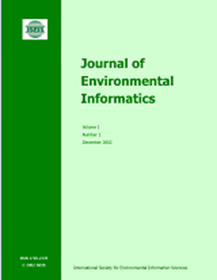Improving Soil Salinity Simulation by Assimilating Electromagnetic Induction Data into HYDRUS Model Using Ensemble Kalman Filter
IF 5.4
1区 环境科学与生态学
Q1 ENVIRONMENTAL SCIENCES
引用次数: 2
Abstract
Assimilation of proximally and remotely sensed information on soil salinization-related attributes into a hydrological model is essential to improve the forecast performance of the profiled soil salinity dynamics for developing appropriate soil amendment practices. Although the family of ensemble Kalman filters (EnKF) is widely used in data assimilation, their applicability and reliability for soil salinization estimation requires further experimental validation. Here, we evaluated the assimilation performance of apparent electrical conductivity (ECa) data obtained from an electromagnetic induction meter (EM38) into the HYDRUS hydrological model. Re-sults showed that the EnKF method improved the simulation accuracy of soil salinity at 0 ~ 100 cm soil depths, as indicated by the de-creased root-mean-square error of 32.6 ~ 76.7% and increased Nash–Sutcliffe efficiency of 9.6 ~ 71.2%. The HYDRUS-simulated values with EnKF were closer to the measured values than the values simulated by the HYDRUS model, and this benefitted from updating the running trajectory of the HYDRUS model. The EnKF values derived from measured ECa data were better than HYDRUS-simulated val-ues with EnKF. Soil salinity simulation was sensitive to ensemble size, error level, and ECa data depth. Considering the ensemble repre-sentativeness and computational efficiency, the optimal ensemble size was judged to be 50. The maximum acceptable observation error was 10%, and observation data to a depth of 100 cm was suggested in EnKF assimilation to minimize the root-mean-square error. It was concluded that proximally sensed EM38 data coupled with the EnKF algorithm is promising for improving the simulation performance and providing a prospective method for simulating large-scale ecological and hydrological processes by coupling multi-source data and hydrological models.利用集合卡尔曼滤波将电磁感应数据同化到HYDRUS模型中,改进土壤盐分模拟
将土壤盐渍化相关属性的近端和遥感信息同化到水文模型中,对于提高土壤盐渍化动态剖面的预测性能,从而制定适当的土壤改良措施至关重要。虽然集合卡尔曼滤波器族(EnKF)在数据同化中得到了广泛的应用,但其在土壤盐碱化估计中的适用性和可靠性还需要进一步的实验验证。在这里,我们评估了从电磁感应计(EM38)获得的视电导率(ECa)数据在HYDRUS水文模型中的同化性能。结果表明,EnKF方法提高了0 ~ 100 cm土壤深度土壤盐分模拟精度,均方根误差减小32.6 ~ 76.7%,Nash-Sutcliffe效率提高9.6 ~ 71.2%。使用EnKF的HYDRUS模拟值比HYDRUS模型模拟值更接近实测值,这得益于HYDRUS模型运行轨迹的更新。ECa实测数据得到的EnKF值优于hydrus模拟的EnKF值。土壤盐度模拟对集合大小、误差水平和ECa数据深度敏感。考虑集合的代表性和计算效率,判断集合的最优规模为50。最大可接受观测误差为10%,建议采用深度为100 cm的观测资料进行EnKF同化,以尽量减小均方根误差。结果表明,EM38近端遥感数据与EnKF算法相结合有望提高模拟性能,为多源数据与水文模型耦合模拟大尺度生态水文过程提供了一种有前景的方法。
本文章由计算机程序翻译,如有差异,请以英文原文为准。
求助全文
约1分钟内获得全文
求助全文
来源期刊

Journal of Environmental Informatics
ENVIRONMENTAL SCIENCES-
CiteScore
12.40
自引率
2.90%
发文量
7
审稿时长
24 months
期刊介绍:
Journal of Environmental Informatics (JEI) is an international, peer-reviewed, and interdisciplinary publication designed to foster research innovation and discovery on basic science and information technology for addressing various environmental problems. The journal aims to motivate and enhance the integration of science and technology to help develop sustainable solutions that are consensus-oriented, risk-informed, scientifically-based and cost-effective. JEI serves researchers, educators and practitioners who are interested in theoretical and/or applied aspects of environmental science, regardless of disciplinary boundaries. The topics addressed by the journal include:
- Planning of energy, environmental and ecological management systems
- Simulation, optimization and Environmental decision support
- Environmental geomatics - GIS, RS and other spatial information technologies
- Informatics for environmental chemistry and biochemistry
- Environmental applications of functional materials
- Environmental phenomena at atomic, molecular and macromolecular scales
- Modeling of chemical, biological and environmental processes
- Modeling of biotechnological systems for enhanced pollution mitigation
- Computer graphics and visualization for environmental decision support
- Artificial intelligence and expert systems for environmental applications
- Environmental statistics and risk analysis
- Climate modeling, downscaling, impact assessment, and adaptation planning
- Other areas of environmental systems science and information technology.
 求助内容:
求助内容: 应助结果提醒方式:
应助结果提醒方式:


